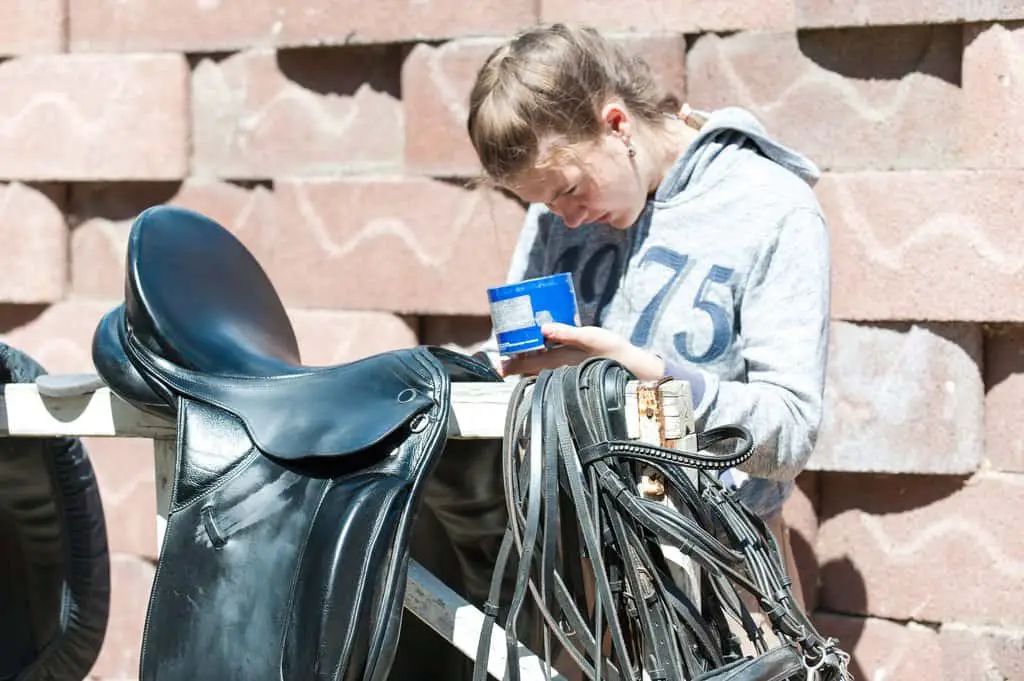Saddle soap is a great product to use if you want to clean leather items effectively, but using it too much can strip away the protective oils of the leather. If you don’t want to deal with dry and cracking leather, you might want to check out other alternatives for saddle soap.
What does saddle soap do to leather?
Saddle soaps are formulated to remove stubborn dirt, grime, and sweat on leather materials while cleaning. It’s also used to bring back the smooth and soft feel of leather as well as restore the rich colors of the material.
However, you will need to condition the leather after using saddle soap to maintain its softness as this type of soap can dry up the fibers. This is why a lot of leather enthusiasts use saddle soap with caution and not too much to avoid the negative effects. Here are some of the pros and cons of using saddle soap on leather:

Pros:
- Great for cleaning and removing tough dirt
- Makes leather look and feel smoother’
- Brings back the leather color
Cons:
- Contains harsh chemicals
- Not suitable for delicate, napped leather materials like suede
- You always need to condition after to prevent leather dryness
What can be substituted for saddle soap?
If you’re someone who gets their leather items dirty and you need to clean them often, it’s a good idea to find alternatives for saddle soap now to avoid complications. Here are some of the best alternatives we could find:
Soap and water
If we’re talking about leather cleaning, the easiest and safest option would be the soap and water cleaning solution. This is the go-to for most people who want to safely clean their leather items if they don’t have leather cleaners or saddle soap.
The key here is to remember to only use mild and pH-neutral (7-8) soap along with lukewarm or warm water. This cleaning solution can effectively remove dirt and stains on leather, and it’s cheap and very easy to make at home. Since this is just a general cleaning solution, always remember to apply a leather conditioner to your item to restore its moisture and suppleness.
White vinegar
White vinegar is not something new in the leather industry when it comes to cleaning and removing unpleasant smells on leather items. It does the same thing a saddle soap does and it’s cheaper and more accessible for everyone. The acidic nature of the vinegar breaks down the stains and bad odor that might be on your leather.
The only downside of using white vinegar on leather is that you need to make sure it’s diluted properly because it can be drying. You can simply make a 1:1 ratio of white vinegar and water. Since vinegar was not made for cleaning leather and because it’s acidic, it’s normal that you need to be cautious to avoid damaging the leather material.
Mink oil
Derived from the fatty tissues of mink, mink oil is considered a fantastic alternative to saddle soap because of its nourishing properties that you can’t find in saddle soap. If you just want to condition your leather and add some protection to it, you can use mink oil since it prevents drying and cracking of the material.
It’s also great for water resistance and UV protection for leather items. Even though it doesn’t do much cleaning, you can still use this as an aftercare for your leather furniture or garments. Just make sure to test this on a hidden spot first as mink oil has a tendency to darken leather pieces. Better yet, avoid using this on light-colored leather items.
Wax leather cleaner
There are many leather cleaners in the market today such as Dubbin or Joseph Lyddy that are used as an alternative to saddle soap. These leather care products are more nourishing compared to saddle soap, plus they are not drying to the material at all.
This soft wax formulation is made from natural oils that are derived from animals. It’s good enough for light cleaning and it can keep the leather fibers supple to prevent it from drying even if you need to use it more often.
Glycerine
Glycerin is a great alternative for saddle soap and it’s actually a common ingredient that you can find in saddle soaps. The difference is that using glycerin alone will ensure that you’re not applying harsh chemicals on your leather compared to saddle soaps that are already formulated with drying chemicals in them.
Since glycerin is considered a natural humectant, meaning it can preserve and retain moisture, it can keep the leather soft and supple. Even though it’s not ideal to use this alone when cleaning leather, you can still use this along with leather-friendly cleaning solutions to help prevent leather stains and dirt.
Leather wipes
Leather wipes are not new in the leather care industry and in fact, there are many leather cleaners you can buy that are in the form of wipes. Not only are these products leather-friendly, but they are also convenient and handy.
Instead of carrying saddle soap everywhere with you, you can simply pull out a wipe and immediately wipe off potential stains on any leather surfaces (except suede). There are also leather wipes that can provide both cleaning and conditioning so you don’t have to worry about the leather fibers drying out once you’re done.
How do you clean tack without saddle soap?
Although tacks are often made to withstand extreme weather conditions and heavy use, you still need to give them care for them to last long. If you want to clean your tack without saddle soap, here’s how you can do it:
- Take your tack apart into pieces for easier cleaning. Remove the buckles, straps, and stirrup leathers.
- We recommend trying the soap and water solution as it is the safest and most effective.
- Wipe off any dirt and grease on the tack using a sponge or soft cloth in circular motions.
- Follow up with a dry microfiber towel after removing any excess moisture and let it dry naturally away from direct heat or sunlight.
You can use any of the alternatives that we mentioned above if you want to clean and condition your leather items. However, if you’re dealing with stubborn dirt on your tack, you can go ahead and buy a dedicated leather cleaner that can deep clean to save you time and effort.
Conclusion
There are many factors that can help you decide whether it’s worth sticking with using saddle soap or not. Saddle soaps are not bad for leather, they’re just a bit harsh since they’re made to clean the items thoroughly. If you want to avoid harsh cleaning agents on your precious leather goods, there are always alternatives to saddle soap that you can choose from.
FAQ
Can I make my own saddle soap?
Yes, you can make your own saddle soap at home using 3 parts of mild soap, 7 parts of water, 2 parts of beeswax, and 1 part of neatsfoot oil. It’s also a great way to avoid using harsh chemicals that are sometimes included in the ingredients in commercial saddle soap.
Is saddle soap water-based?
There are definitely water-based saddle soaps that you can find in the market. However, not all saddle soaps are water-based and sometimes they can come in the form of a paste or balm. It can also come in a liquid form stored inside a spray bottle for easier application.
What can I use instead of leather shampoo?
You can use the water and vinegar solution as an alternative to leather shampoo. This cleaning solution is generally safe for almost all leather surfaces and you can always test it in a hidden spot to see if there’s any discoloration. You can also mix 2 parts of water for 1 part of white vinegar if you think the 1:1 ratio is too harsh for your leather goods.
Is vaseline good for leather?
If you want to moisturize your leather item, you can try applying vaseline or petroleum jelly if you don’t have leather conditioners. However, it won’t do its job as well as leather conditioners and obviously, you can’t use it on suede or nubuck. We also don’t recommend using vaseline or petroleum jelly on faux leather as it can damage the protective coating.



